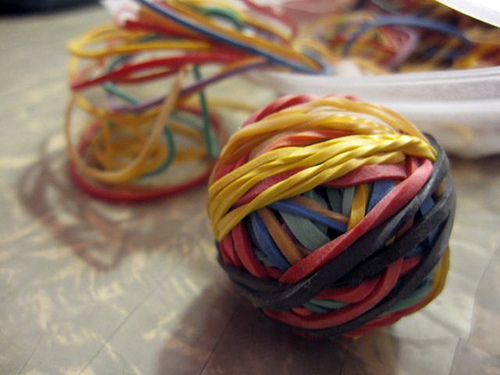An easy fix for spinning wheels with Scotch tension problems

After writing last week about my problems with Scotch tension, I thought that I had it licked, but it came back. I have only had the wheel for about two months, and it's my first experience with a spinning wheel, so I was really stumped. It had been fine for a while, but now it seemed like someone was sitting next to me, randomly tightening and loosening the Scotch tension. Maddening!
I finally went searching through the Ravelry forums. It took a long time before I found a thread about the problem I was experiencing. (Most of the questions about Scotch tension are more along the lines of "Why?" and "What?" than advanced troubleshooting.)
The answer to the problem was unanimous, from several experienced spinners: replace the little metal spring with a rubber band.
"A rubber band?" I wondered. This seemed crazy and dumb, like one of those things people always recommend without ever having tried it. (Have you ever actually tried to use a cut potato to get a broken light bulb out of the base? It does not work. You know what does work? Needle nose pliers. You're welcome.)
I set my skepticism aside, untied the tiny spring, and tied on a fabric-covered hair band. (Why do I still have a pack of these? I cut my hair short four years ago and have no plans to grow it out again.) And much to my amazement, it worked.
I guess as the metal springs age, they can get rusty and stiff. As opposed to a rubber band, which has infinite flexibility, a spring can be unreliable. You have to replace the rubber band every few years when it breaks, but this is easy enough to do.
In fact, the process of adjusting the tension with a rubber band is so amazing, swapping it out is the first thing I would do with a new wheel. If you are having Scotch tension problems, I highly recommend giving this a try!
Image courtesy Flickr/shorts and longs

0 comments